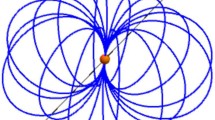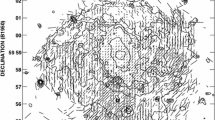Abstract
In the present paper we consider the frequency spectrum, time variations and polarization of the flux of synchrotron radio emission from a source which consists of two components flying apart in opposite directions with relativistic velocities at the same time expanding. A comparison of the calculations with unusual ‘double-humped’ spectra of some radio sources suggests the existence in their nuclei of such double components which are at an early stage of relativistic ejection. In particular the double-humped spectra of 3C 84 and 4C 50.11/NRAO-150 can be interpreted in the proposed model (see Figures 6, 7, 12 and Equations (22), (32)). In this model the ratio of maximum frequenciesv 1m/v 2m should be larger than that of the maximum fluxesF v1m (1)/F v2m (2).
The linear polarization of the double-humped spectrum is analysed. It is found under rather specific conditions that at the low-frequency maximum of the spectrum of the type given in Figures 6 and 7 a lower degree of linear polarization is expected than at the high-frequency maximum. In addition, it is natural to expect the appearance of circular polarization in sources with internal largescale relativistic motions. The time variations of the radio flux of some QSS, N-galaxies, and nuclei of Seyfert galaxies can also be interpreted in the suggested model of two clouds of relativistic electrons flying apart in different directions with relativistic velocities while simultaneously expanding. For example, Figure 11 shows the flux variations at 3 frequencies whose ratio is 16:4:1. This picture is similar to the observations of 3C 279 at 3.4 mm, 2 cm and 6 cm, and several other sources (Kellermann andPauliny-Toth, 1968).
There have been a number of attempts to explain the flux variations of radio sources in the model of successive, but unrelated outbursts of clouds of relativistic electrons caused by supernova explosions. This model meets many difficulties and seems improbable. In this paper we suggest experimental tests to make a final choice between the model of double components flying apart relativistically and the model of two successive, but unrelated, outbursts from supernovae.
If the suggested model of explosions in radio sources is correct, then the processes of variable energy output in such different populations as QSS, N-galaxies, radio-galaxies and the nuclei of normal galaxies have a similar nature, differing only in quantity.
Similar content being viewed by others
References
Ginzburg, V. L.: 1964,The Propagation of Electromagnetic Waves in Plasmas, Pergamon Press, London.
Ginzburg, V. L. andOzernoy, L. M.: 1966,Astrophys. J. 144, 599.
Ginzburg, V. L., Sazonov, V. N. andSyrovatski, S. I.: 1968,Uspekhi Fiz. Nauk 94, 63.
Gudzenko, L. I., Ozernoy, L. M., andChertoprud, V. E.: 1967,Nature 215, 605;218, 353.
Gudzenko, L. I., Ozernoy, L. M., andChertoprud, V. E.: 1968,Astron. J. (USSR) 45, 492.
Hughes, V. A. andPorter, R. V.: 1968,Nature,217, 832.
Kaplan, S. A.: 1967,Astron. J. (USSR) 44, 521 (Soviet Astron. AJ 11, 416).
Korchak, A. A. andSyrovatski, S. I.: 1961,Astron. J. (USSR) 38, 885 (1962,Soviet Astron. AJ 5, 678).
Kellermann, K. I. andPauliny-Toth, I. I. K.: 1968,Ann. Rev. Astron. Astrophys. 6, 417.
Kulsrud, R. M., Bernstein, I. B., Kruskal, M., Fanucci, I. andNess, N.: 1965,Astrophys. J. 142, 491.
Ozernoy, L. M.: 1966,Astron. J. (USSR) 43, 300 (Soviet Astron. AJ 10, 241).
Ozernoy, L. M.: 1968a, Symp.Variable Stars and Stellar Evolution, Moscow, 1964, Nauka Publishing House, Moscow), p. 140.
Ozernoy, L. M.: 1968b,Astron. Tsirk. (USSR) No. 469, 1.
Ozernoy, L. M.: 1969,Astron. J. (USSR) 46, (in press).
Ozernoy, L. M. andSazonov, V. N.: 1968.Nature 219, 467.
Ozernoy, L. M. andSazonov, V. N.: 1969,Astron. J. (USSR) 46, (in press).
Ozernoy, L. M. andSomov, B. V.: 1969,JETP (USSR) (in press).
Pauliny-Toth, I. I. K. andKellermann, K. I.: 1966,Astrophys. J. 146, 643.
Pauliny-Toth, I. I. K. andKellermann, K. I.: 1968,Astrophys. J. 152, L169.
Piddington, J. H.: 1966,Monthly Notices Roy. Astron. Soc. 133, 163.
Razin, V. A.: 1960,Radiofizika 3, 921.
Rees, M.: 1966,Nature 211, 468.
Rees, M.: 1967,Monthty Notices Roy. Astron. Soc. 135, 345.
Ryle, M. andLongair, M. S.: 1967,Monthly Notices Roy. Astron. Soc. 136, 123.
Ryle, M. andWindram, M. D.: 1968,Monthly Notcies Roy. Astron. Soc. 138, 1.
Sazonov, V. N.: 1969a,JETF (USSR) 56 (in press).
Sazonov, V. N.: 1969b,Astron. J. (USSR) 46 (in press).
Sazonov, V. N. andTsytovich, V. N.: 1968,Radiofizika 11, 1287.
Shklovsky, I. S.: 1965,Astron. J. (USSR) 42, 30.
Sturrock, P. A.: 1966,Nature 211, 697.
Van der Laan: 1966,Nature 211, 1131.
Tsytovich, V. N.: 1951,Vestnik Mosc. Gos. Univer 11, 27.
Author information
Authors and Affiliations
Additional information
Translated by D. F. Smith.
Rights and permissions
About this article
Cite this article
Ozernoy, L.M., Sazonov, V.N. The spectrum and polarization of a source of synchrotron emission with components flying apart at relativistic velocities. Astrophys Space Sci 3, 395–423 (1969). https://doi.org/10.1007/BF00653362
Received:
Issue Date:
DOI: https://doi.org/10.1007/BF00653362




